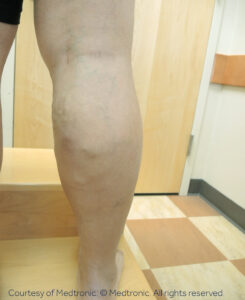When you look down, do you notice blue veins on legs? Are you wondering if veins visible on legs is a medical problem? Here’s what you need to know.

When you notice blue or purple veins that are visible on your legs, they could be spider veins or varicose veins. And, while people use those terms interchangeably, they’re actually quite different.
If you have spider veins, it means that tiny veins near the surface of your skin have stretched because of early vein disease. They usually appear as red or blue veins on legs, and can cluster together, looking like a spider web.
Varicose veins are also a symptom of vein disease. But, with this degree of progression, the veins visible on legs will also appear bulging and twisted. Now, while both conditions hurt your legs’ cosmetic appearance, they are also signs of malfunctions with your veins. So seeking medical treatment is important. And the sooner the better, since vein disease is progressive, which means your symptoms will get worse over time without intervention.
As we’ve reviewed, veins that become visible on your legs are a common symptom. But with varicose veins, you may also experience:
- Leg pain, especially after sitting or standing for extended periods
-Swelling
- Leg ulcers that won’t heal
- Bleeding from an affected vein
- Changes to the skin on your legs and ankles, including dry or scaly patches, or hardening around the varicose veins
- Itchy skin
- Skin color changes around the problem veins
-Foot and ankle swelling (edema)
- Leg cramps
Varicose veins are veins that aren’t working properly. Normally, your veins work to send de-oxygenated blood back to your heart from the rest of your body. To help them do that, your veins contain valves that open and close to help push the blood upwards against gravity. Sometimes, those valves stop doing their jobs, and that allows blood to build up. Especially in the veins in your legs. Next, the blood stretches and thins your veins, making them bulge. Now, those blue veins on legs give you visual proof that somethings wrong with your circulatory system. But why would your valves stop working efficiently?
Often this is a side effect of aging, since your veins naturally stretch and thin as you get older. This lets more blood pool in your legs, which can overwhelm your valves. It can also happen if you suddenly gain weight, as during pregnancy, since the extra pounds puts more pressure on your legs, making it harder to push blood out and up to your heart. Even your job, or a long plane trip, can contribute to vein disease, since standing or sitting for long periods puts pressure on your legs. Which, in turn, can compromise circulation.
Whatever is causing veins that are visible on your legs, seeking early treatment matters. Because, without intervention, symptoms will worsen. And that may leave you with more invasive treatment requirements.

As we’ve mentioned, if you ignore vein disease, it gets worse. Untreated varicose veins can create inflammation in your legs. Then, as blood builds up over time, the combination can lead to Hyper-pigmentation, when the skin on your legs or feet turns darker or becomes discolored.
Without treatment, you may also develop venous ulcers. These open sores are very hard to heal, leaving you vulnerable to infection. They most often form where your skin is thinnest, just above the ankles. But you could develop a venous ulcer at any spot on your legs where extra blood leaks from your veins and through your skin, causing tissue damage.
Sometimes, the blood seepage isn’t noticeable until an ulcer forms. But, at other times, the swelling and pressure from your bulging veins builds up tremendously. Then, even a small bump or cut can cause you to bleed extensively from your varicose veins.
Perhaps more seriously, veins visible on legs are more at risk for blood clots. And that risk applies to both your surface level veins and your deep leg veins. (When that happens, the clot is know as a deep vein thrombosis, or DVT. This type of clot is considered a medical emergency because it can break free and travel to your lungs.)
If you have a family history of vein disease, there are steps you can take to prevent varicose veins from forming. First, think about wearing compression socks, especially during long car rides or when traveling by airplane.
Next, get regular exercise. Any activity is good for circulation. But workouts like walking, biking or even calf raises are particularly effective because they strengthen the muscles in your legs that help pump blood up to your heart.
Always try to move positions, avoiding sitting or standing for too long a time. Look carefully at your wardrobe—tight jeans or even Spanx could impact your blood flow. And do your best to follow a healthy diet and maintain your ideal weight.
Of course, prevention won’t work for everyone. So, if you look down and see blue veins on legs, don’t cover up and hope the problem will go away. Instead, schedule a consultation with our Houston and Dallas area vein specialists right away. We’ll review your treatment options and come up with a plan to protect you from further vein disease complications.

Scheduling
Please contact our dedicated specialists to schedule a consultation today.
2025 Texas Endovascular. All rights reserved. Website Design by Healthcare Success